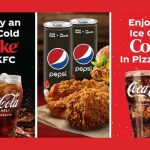In Xujiahui district in Shanghai lies a KFC that isn’t typical.
Customers line up before a row of touchscreen kiosks, keying in orders while a camera scans their faces to process payment in less than a second.
Downstairs, a robot arm whirs to life to prepare an ice cream cone. Diners can choose the joint’s background music via app and listen to a favorite tune while they eat.
So far only a few hundred KFC locations have been similarly tricked out. But Yum China Holdings Inc. says 86 percent of transactions are already cashless and about half of orders are placed via mobile app or digital kiosk at its more than 8,400 KFC, Pizza Hut, and Taco Bell restaurants.
The next step is to harvest data from the more than 180 million Chinese who belong to KFC and Pizza Hut loyalty programs and use artificial intelligence to customize a menu for each diner based on preferences and local tastes. Yum says the AI-powered menu, introduced in January, has already boosted average per-order spending by 1 percent—the equivalent of about $840 million worth of fried chicken and pan pizzas each year.
China’s biggest fast-food operation, Yum is seeking to maintain its dominance amid intensifying competition from a newly assertive McDonald’s Corp. (under Chinese management since 2017) and smaller U.S. chains such as White Castle and Shake Shack, as well as local fast-food operations looking to undercut the incumbents on price.
In big urban centers, shopping is increasingly cashless, convenience stores are unmanned, and everything from forks to furniture can be delivered within hours. For most Chinese, such convenience has so far trumped privacy concerns, so companies such as Yum are able to collect customer data with relative impunity.
The menu on KFC’s app pushes items to customers based on their ordering patterns and local demographics. “The menu is customized based on who they are, and it takes less time to order food, so customers are happy,” Wat says. “We know the transaction pattern of each store, which lets us do better forecasting, which means we have less waste. And that enables us to achieve better margins and be very careful about increasing prices.”
The selection bears little resemblance to the value meals and buckets of traditional Middle America KFC. In China, fried chicken is sold by the piece and easily mixed and matched with such local favorites as rice rolls, egg tarts, and lotus soup.
Car salesman Xia Baohua, a KFC regular who tries to eat healthy, sees soup or corn when he opens the app rather than fries or ice cream. Xia, 48, typically gets a piece of chicken, side salad, and hot tea, which he orders by smartphone for pickup while he walks from the subway to the auto dealership. “I like that it’s convenient, trustworthy, and healthy,” he says. “There aren’t many other chains in China like that.”
“Because Chinese consumers are so mobile and used to convenience, they are also more fickle,” says Jason Yu, Shanghai-based general manager of research firm Kantar Worldpanel China. “Loyalty to any chain is fragile.” In 2013 a food safety scare, a bird flu outbreak, and local competition precipitated a two-year slump for KFC.
Yu says Yum’s technological push and data mining can’t hurt. “The fun and efficient customer experience can help attract eyeballs,” he says. “But ultimately it’s health and food safety that makes or breaks a fast-food chain.
source:http://www.bloomberg.com
MARKETING Magazine is not responsible for the content of external sites.
After 20 years of evolving technology, shifting market trends, and adapting to changing consumer behaviour, the media landscape has nearly reached saturation.
We’ve optimised to the fullest, providing advertisers with abundant choices across technology, platforms, data-driven marketing, CTV, OTT, DOOH, influencer marketing, retail, etc.
Media specialists have diversified, but with more options comes the challenge of maintaining income growth. The industry is expanding, but revenue isn’t keeping pace.
Now, we’re at a TURNING POINT: time to explore and harness new sustainable revenue streams. While GroupM forecasts a 7.8% global ad revenue growth in 2024, challenges like antitrust regulation, AI and copyright issues, and platform bans persist.
Collaboration is key: partnerships that thrive on synergy, shared values, and aligned goals are becoming increasingly essential.
Hence, the Malaysian Media Conference, in its 20th year, has assembled the partners and players under one roof on October 25 for a day of learning, sharing, and exploring.
REGISTER NOW










